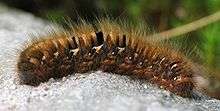Lasiocampa quercus
Lasiocampa quercus, the Oak Eggar, is a common moth of the family Lasiocampidae found in Europe, including Britain and Ireland. It feeds on a variety of plant species, and may develop over two years in higher latitudes, where it may be known as the Northern eggar. Its suffix quercus refers to the fact that its cocoon generally resembles an acorn.
| Oak Eggar | |
|---|---|
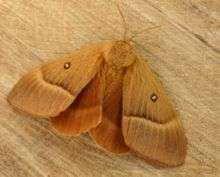 | |
| Scientific classification | |
| Kingdom: | |
| Phylum: | |
| Class: | |
| Order: | |
| Family: | |
| Genus: | |
| Species: | L. quercus |
| Binomial name | |
| Lasiocampa quercus | |
Habitat
The Oak Eggar's habitat is wide-ranging, including scrub, heath, moor, downland, hedges and sea cliffs, reflecting the larva's very varied range of food plants.[1]
Lifecycle
Adult
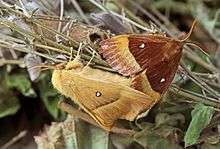
The moth's wingspan is about 45mm (male) to 75mm (female), the female being larger and paler than the male. It is Britain's largest day-flying moth.[2]
The Oak Eggar is on the wing for about two months between May and September, depending on the latitude. In more northerly latitudes, development can span two years, with larvae over-wintering the first year, and the pupae in the second year. In Northern areas it is known as the Northern Eggar; this was formerly thought to be a separate species, but is generally assumed to be a subspecies Lassiocampa quercus callunae, there is no clear geographical separation of the two types, but the Northern Eggar tends to be the larger of the two.[2] There are morphological differences and different food preferences.[3] Males tend to be day fliers, while females tend to fly from dusk.[4][5]
Unpaired females may attract a large number of males, and eggs are laid loosely in undergrowth.[6]
Larva
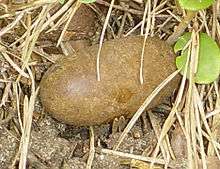
According to different sources, larvae feed on a wide variety of plant species, low down, including blackthorn, hawthorn, viburnum, dogwood, ivy and ling,[4] or bilberry, broom, larch, birch, willow, hazel, sea buckthorn and Rubus species, including bramble. It is not known to feed on oak;[5] however, one entomologist (Brues, 1924) is quoted as saying:
The Oak Eggar caterpillar (Lassiocampus quercus), a pest particularly of oak forests, is known to be capable of adapting itself to a variety of trees in default of oak...[7]
Larvae can be infected by a virus that changes their behaviour, causing them to climb out of the protection of low scrub and leave them open to predation, facilitating the spread of the infection.[8][9]
The caterpillar hairs of some species of moth, such as the oak processionary moth (Thaumetopoea processionea), can cause skin irritation,[10] but there is no evidence that the oak eggar is one of these, despite the similar name.
Pupa
The caterpillar pupates on the ground inside a silken cocoon, the exterior of which is hard and yellowish, and resembles an acorn, hence the moth's name.[4][5][6] "Eggar" is an obsolete word again relating to the shape of the cocoon.[11]
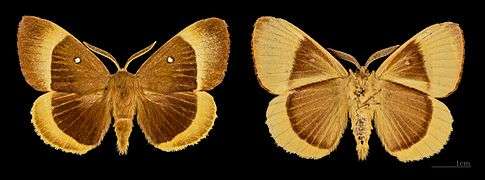 Male, dorsal left (Muséum de Toulouse)
Male, dorsal left (Muséum de Toulouse) Female, dorsal left (Muséum de Toulouse)
Female, dorsal left (Muséum de Toulouse)
References
- "Butterfly Conservation: Oak Eggar/Northern Eggar". Retrieved 1 April 2018.
- Newland, D., Still, R. & Swash, A. (2003). Britain's Day-flying Moths. Princeton University Press. ISBN 9781400846900. Retrieved 1 April 2018.CS1 maint: multiple names: authors list (link)
- Young, M (2010). The Natural History of Moths. Bloomsbury. p. 55. ISBN 9781408149539. Retrieved 1 April 2018.
- R. L. E. Ford, FRES, FZS (1963). Larger British Moths. Frederick Warne, Observer Series.CS1 maint: multiple names: authors list (link)
- "UK Moths: Oak eggar". Retrieved 1 April 2018.
- George E. Hyde FRES (18 May 1961). The courtship of moths. New Scientist. 235. pp. 392–395. Retrieved 1 April 2018.
- Wardle, R. A. (1929). The problems of applied entomology. Manchester University Press. p. 4. Retrieved 1 April 2018.
- "'Zombie virus' outbreak causes caterpillars to explode". The Telegraph. 2 August 2017. Retrieved 1 April 2018.
- "Caterpillars turned into 'exploding zombies' by bug". BBC News. 2 August 2017. Retrieved 1 April 2018.
- "Forestry Commission: Oak processionary moth (Thaumetopoea processionea)". Retrieved 1 April 2018.
- Marren, P. & Mabey, R. (2010). Bugs Britannica. Random House. p. 274. ISBN 9780701181802. Retrieved 1 April 2018.CS1 maint: multiple names: authors list (link)
External links
| Wikimedia Commons has media related to Lasiocampa quercus. |
| Wikispecies has information related to Lasiocampa quercus |
- Fauna Europaea
- Lepiforum.de (in German)
- Vlindernet.nl (in Dutch)
